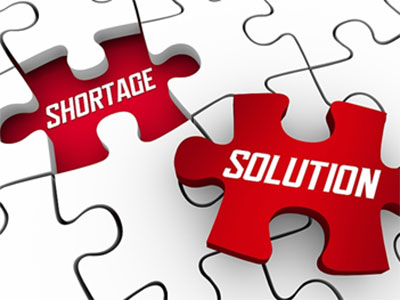

Manufacturers wish they left supply chain shortages behind after the pandemic, but they remain top of mind. Concerns remain. According to KPMG, “71% of global companies highlight raw material costs as their number one supply chain threat for 2023.” And the trend isn’t ceasing. According to a survey by LeanDNA and Wakefield Research, supply chain shortages remain a leading concern for manufacturers as they look to the future.”
In fact, if you look at the pharmaceutical industry, shortages have been creating havoc. For example, there have been shortages of over-the-counter drugs and prescription medications for ADHD, cancer and diabetes have been widespread. There has been commentary about a spike in demand, but there are also comments about manufacturing delays. Of course, this is before we discuss the state of logistics disruption.
In addition to product, material and healthcare shortages, clients are experiencing a severe shortage of high-skilled talent and are struggling to upgrade ERP systems and related technologies. These issues are aggravating the shortage situation as multiple clients have the lack of system support creating further shortages and work stoppage in addition to frustrating their employees.
It is simply creating havoc as people jump into jobs they are not prepared to execute, and Executives are struggling to understand why their resources no longer seem to have the expertise they used to have. Worse yet, if they don’t realize this is occurring, the situation gets worse as employees make poor decisions and struggle to keep up. Refer to our article, Where the Talent Has Gone & Strategies for Success.
Strategies for Success
Customers will not suffer endlessly as shortages persist. They will find alternative sources of supply, source from different regions of the world, find backup sources, search for suppliers that can provide visibility and status of the end-to-end supply chain and invest in reshoring, nearshoring, and expanding regional manufacturing footprints.
Thus, proactive executives are getting ahead of these challenges. We have no doubt that the companies that can supply critical items in the next several years with uninterrupted supply will lead their industries for decades to come. What are some of the best practice strategies being deployed?
- Go back to the basics: It is simply surprising how many clients are running into problems with the fundamentals. Who knew a best practice was to return to basics! According to a leading authority on the subject of generational diversity in the workplace, the younger generations is struggling with ambiguity and decision making. This has proven to be “on the mark” as clients have employees stuck and struggling as they don’t know why the computer is spitting out answers that are wrong and what to do about it. Thus, we are jumping in to define processes, educate on concepts and help clients over this unexpected bottleneck. Perform a supply chain assessment to quickly size up where to focus. Take our complimentary supply chain assessment quiz.
- Planning best practices: There is no doubt that production planning, materials management, replenishment planning, and each planning expertise is in limited supply yet is cornerstone to mitigating shortages and getting in front of demand. Refer to recent examples of how this topic can make or break success in our recent article.
- SIOP (Sales Inventory Operations Planning): One of the single best strategies to get in front of changing conditions and ensure profitable growth is to rollout a SIOP process. A SIOP process will align Sales with Operations, demand with supply, and, most importantly, it will provide a proactive view into changing circumstances with recommended solution options, impacts on product and customer profitability, heads up to capacity bottlenecks, and sales funnel changes. Read our book, SIOP: Creating Predictable Revenue and EBITDA Growth.
- ERP, advanced technologies & automation: No client will succeed with manual spreadsheets long-term. The most successful clients are better utilizing their ERP systems to provide enhanced visibility, flexibility, and service while also pursuing advanced technologies (digital twins, artificial intelligence, IoT, robotics, meta) and automation to improve efficiencies, reduce errors, and increase scalability and profitability.
- Innovation: Continuous improvement is no longer enough. Only those companies that innovate and turn 1+1 into 22 with collaborative partnerships will succeed.
- Trends & Metrics: Although it is essential to review progress and results by tracking key performance indicators like OTIF (on-time-in-full), production output, and inventory turns, it is even more important to be focused on “where the puck is going” (not where it has been). Tracking trends, listening to diverse perspectives, researching and trialing new and potential trends is the focus of our most successful clients.
- Regional manufacturing: Although this topic should arise through your SIOP process, our money is on regional manufacturing. Clients must take control over their ability to service customers. Reshoring, nearshoring, expanding manufacturing and collaborative partnerships are hot topics. For example, even industries such as medical device, pharmaceutical, and computer chips are joining aerospace, food & beverage, industrial equipment, and building products to produce close to customers.
- Talent: We’d be remiss not to mention that talent will “win” in the end. Attract, hoard, develop, train, and mentor talent!
Shortages are persisting. Geopolitical tensions remain high. Critical supplies such as computer chips, medical supplies, and aerospace and defense products are providing evidence that it isn’t just a lack of “nice-to-have” items. Pursue strategies to ensure you are ahead of the curve, and your business will thrive.
If you are interested in reading more on this topic:
Why Manufacturing Matters and Will Thrive in the Next Decade


